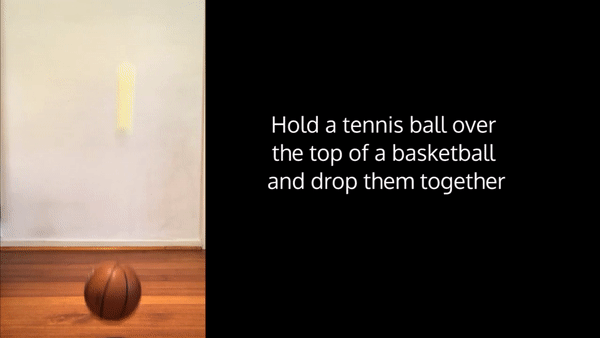Use a basketball and a tennis ball to examine transfer of energy
What you need
- basketball
- tennis ball
- golf or squash ball (optional and tricky to get three balls balance on top of each other)
What to do
1. Drop the basketball from as high as you can reach. Notice how high it bounces.
2. Drop the tennis ball from as high as you can reach. Notice how high it bounces.
Question: What do you observe about the height the two balls bounce compared to the height you dropped them from? Can you explain your observation?
3. Hold the tennis ball over the top of the basketball and drop them together (It’s tricky. You might have to repeat this a few times before you get the tennis ball to fly straight up).
Question: How high does the tennis ball go? How high goes the basketball go?
Can you explain your observations?
Just for laughs
Replace the tennis ball with the egg or water balloon and place students around as just like slips fielders in cricket. They need to try to catch the egg/water balloon as they fly off at the unexpected angles (best done outdoors).
More Questions
Does the basketball have any energy when held in the hand not moving (ie you have not dropped it yet)? Discuss.
Does it have any energy when it is falling? Discuss.
How high does the tennis ball go compared to when it was dropped by itself? It might be difficult to get an accurate measurement and it might have to be an estimate, e.g., it flew 4, 5 or ten times higher than when it was dropped by itself.
What is happening
When the balls are dropped by themselves they lose some energy when they hit the ground. They also lose a bit of energy passing through the air as heat from friction [Bonus question – would a moving ball in space (or vacuum) lose energy from friction?]. Gravity also acts on the balls as they rebound, trying to pull them toward the ground. These all combine to make the balls rebound to a lower height from which they were dropped.
When the balls are dropped together, the tennis balls bounces extremely high because it gains energy from the basketball. Because the basketball transfers its energy to the tennis ball, it barely bounces at all.
Potential energy: The stationary ball does have energy. It has potential gravitational energy. That is, there is the force of gravity acting on the ball pulling it toward the Earth. The basketball has the potential to do work. Once dropped it converts that potential gravitational energy into kinetic energy (movement).
Extension
If you want to make this more quantitative get students to work out the following. (Note: your measurements will be different and the many variables make the following approximate):
The tennis ball gains about 16 times more energy when it bounces off the basketball and it gets this energy from the basketball as it rebounds off the floor. That is, if we assume we drop the ball from a height of 1 metre, the average return height for the tennis ball rebounding off the floor is 0.55 metres and the tennis ball rebounds off the basketball to a height of 9 metres then 9/0.55 = 16 (or close enough).
To help understand the role of mass. Get students to reverse the balls in the drop. That is, put the basketball on top of the tennis ball, then drop them.
Check the full teacher resource and answers for this activity here.
And in this video, Physics Girls also extends this activity and links it to Supernovae
Back to Home Science activities.

